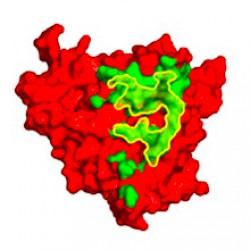Making Antibodies That Neutralize HIV
Making Antibodies That Neutralize HIV
Researchers have traced in detail how certain powerful HIV-neutralizing antibodies evolve, generating vital clues to guide the design of a preventive HIV vaccine.

- Illustration showing, in green, where the mature VRC01antibody binds to gp120 (red) on the surface of the HIV virus. Image by Wu et al., courtesy of Science
Most vaccines work by triggering the immune system to produce antibodies to help beat back infections. But proteins on the surface of HIV mutate rapidly, changing shape and preventing most antibodies from latching onto and neutralizing the virus.
Last year, scientists at NIH’s National Institute of Allergy and Infectious Diseases (NIAID) identified 2 HIV antibodies that could stop more than 90% of known global HIV strains from infecting human cells in the laboratory. Called VRC01 and VRC02, the antibodies were found in blood from an HIV-infected donor in North America. Led by NIAID’s Drs. Peter Kwong and John R. Mascola, the researchers subsequently discovered antibodies similar to VRC01 in the blood of 2 HIV-infected African donors.
The scientists found that the genes for VRC01-like antibodies undergo an unusually high number of mutations—70 to 90—between the first draft, which codes for a weak antibody, and the final version that codes for an antibody that can neutralize HIV. The scientists thus set out to map the route by which these antibodies develop. Their report appeared in the advanced online edition of Science on August 11, 2011.
Structural analysis revealed that the VRC01-like antibodies from the different donors all bind in the same way to the same spot on HIV. They attach to a molecule called gp120 in a region known as the CD4 binding site. HIV uses this site to attach to the cells it infects. It is one of the few parts of the virus that stays the same across HIV variants worldwide.
The genes for antibodies lie in the DNA of immune cells called B cells. To track the evolution of the antibody response to HIV at the genetic level, the researchers examined the B-cell DNA of 2 donors using a method called deep sequencing, along with sophisticated bioinformatics. Among hundreds of thousands of antibody genes, the researchers identified thousands that code for VRC01-like antibodies. They then sorted these genes into family trees showing their evolution from their earliest stage into mature forms. Next, the researchers focused on the gene segment that codes for the part of the antibody that attaches to and neutralizes HIV. They examined these sequences in detail to reveal how they changed step by step from their original state into a mature form.
“To make a vaccine that elicits VRC01-like antibodies, we will need to coach B cells to evolve their antibody genes along one of several pathways, which we have now identified, from infancy to a mature, HIV-fighting form,” says Dr. Gary J. Nabel, director of NIAID’s Vaccine Research Center.
The scientists now aim to create proteins they can deliver through a vaccine to serve as signposts that direct the development of B-cell DNA to produce VRC01-like antibodies.
This research has far-reaching implications for vaccine development. “As we develop and test new HIV vaccines, it will be possible to analyze not just antibodies in the blood, but also the specific B-cell genes that are responsible for producing antibodies against HIV,” Mascola says. “This information will indicate whether an investigational HIV vaccine in a preclinical or clinical trial is heading in the right direction.”
* The above story is reprinted from materials provided by National Institutes of Health (NIH)
** The National Institutes of Health (NIH) , a part of the U.S. Department of Health and Human Services, is the nation’s medical research agency—making important discoveries that improve health and save lives. The National Institutes of Health is made up of 27 different components called Institutes and Centers. Each has its own specific research agenda. All but three of these components receive their funding directly from Congress, and administrate their own budgets.




















